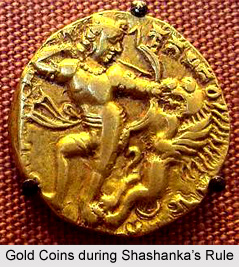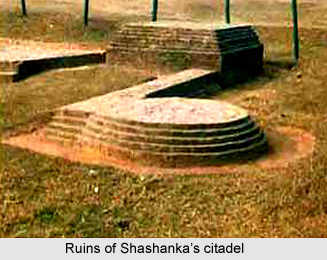 Shashanka was a ruler who came to be known as the first independent king reigning over a united Bengal, particularly known as `Gauda`. According to historical sources, Shashanka was a significant figure in the field of the political history of Bengal. He used to rule during the 7th century AD and certain historians are of the view that his regime continued between 59 AD and 625 AD. Other famous contemporary kings of his time were Harshavardhana and Bhaskar Varman of Kamarupa, and `Karnasuvarna` or `Kanshona` was the capital of his empire. Currently, Karnasuvarna is situated in modern-day Murshidabad. It is said that the Bengali calendar`s development is linked to Shashanka since the starting date of Bengali calendar falls closely during his rule.
Shashanka was a ruler who came to be known as the first independent king reigning over a united Bengal, particularly known as `Gauda`. According to historical sources, Shashanka was a significant figure in the field of the political history of Bengal. He used to rule during the 7th century AD and certain historians are of the view that his regime continued between 59 AD and 625 AD. Other famous contemporary kings of his time were Harshavardhana and Bhaskar Varman of Kamarupa, and `Karnasuvarna` or `Kanshona` was the capital of his empire. Currently, Karnasuvarna is situated in modern-day Murshidabad. It is said that the Bengali calendar`s development is linked to Shashanka since the starting date of Bengali calendar falls closely during his rule.
Extent of Kingdom of Shashanka
King Shashanka was known as the `Lord of Gauda` and his royal kingdom extended much beyond the area of Gauda. Within the conclusion of his regime, his empire stretched to Bhuvansha from `Vanga`, and continued till the border of Kamarupa. Bengal was classified into three subdivisions prior to the rule of Shashanka, named Gauda, Samatata and Banga. This land was then administered by an incapable ruler called Mahasengupta who belonged to the Gupta Dynasty. Shashanka was amongst the chieftains of Mahasengupta who steadily reached the zenith of power, owing to the weakness of the ruler. Following the death of Mahasengupta, his successors were deprived of their ancestral kingdom by Shashanka who drove them out of their own territories and founded his very own empire referred to as Gauda.
 Various accounts of the life of King Shashanha have been obtained from accounts of his contemporaries Bhaskaravarman and Harshavardhana, particularly their copper plates. Information about his lifestyles have also been derived from copper plates of the King of Ganjam, Madhavavarma, as well as accounts written by Zuanzang, a Chinese monk. Certain coins which were minted during the rule of King Shashanka also speak volumes about this ruler of Bengal. However, Shashanka was a Brahmin, and therefore it is believed that the information communicated by Zuanzang and Bana might not be very trustworthy. It is also believed that these two writers were patronized by one of the enemies of King Shashanka, so there might be a probability that their accounts might be tinged with a certain degree of biasness. According to Bana and Zuanzang, Shashanka was described as a `vile Gauda serpent` and that he had demolished Buddhist stupas of Bengal. Their accounts also state that Shashanka had announced an award of one hundred gold coins for the severed head of all the Buddhist monks of his empire.
Various accounts of the life of King Shashanha have been obtained from accounts of his contemporaries Bhaskaravarman and Harshavardhana, particularly their copper plates. Information about his lifestyles have also been derived from copper plates of the King of Ganjam, Madhavavarma, as well as accounts written by Zuanzang, a Chinese monk. Certain coins which were minted during the rule of King Shashanka also speak volumes about this ruler of Bengal. However, Shashanka was a Brahmin, and therefore it is believed that the information communicated by Zuanzang and Bana might not be very trustworthy. It is also believed that these two writers were patronized by one of the enemies of King Shashanka, so there might be a probability that their accounts might be tinged with a certain degree of biasness. According to Bana and Zuanzang, Shashanka was described as a `vile Gauda serpent` and that he had demolished Buddhist stupas of Bengal. Their accounts also state that Shashanka had announced an award of one hundred gold coins for the severed head of all the Buddhist monks of his empire.
War of Shashanka with Harshavardhana
Shashanka had engaged in violent warfare with the then Emperor of Thanesar who was named Harshavardhana as well as all his allies. However, the outcome of the battle is mysterious since historical accounts have claimed that Shashanka had continued to rule over his lands with dignity after the battle. Devgupta, who was the ruler of Malwa was a sworn enemy of the king of Kannauj, Grahavarman, who was said to be the brother-in-law of the Vardhan princes. This was due to the fact that Grahavarman was married to Rajyashri, the princess of Thanesar. Kannauj was attacked by Devgupta and captured and killed Devgupta. Thereafter, Devgupta`s wife Rajyashri was taken prisoner by him. Prabhakarvardhan, the ruler of Thanesar died at the shock of the news and soon after his elder son Rajyavardhan was crowned the new ruler of Thanesar.
In order to take revenge for the death of Grahavarman, Rajyavardhan fought a battle against Devgupta at Kannauj, where he was defeated and killed. It has been suspected that Shashanka had later rendered his cooperation at this battle as part of a treachery, though conclusive proofs are absent which make this suspicion certain. Harshavardhana was then made the new king of Thanesar who assembled an army and launched an attack on Kannauj. Some historical accounts have indicated that Shashanka and Devgupta were compelled to retreat from Kannauj, though Shashanka continued to rule Gauda. However, Harshavardhana made frequent attacks to his empire, which was boldly counteracted by Shashanka.



















